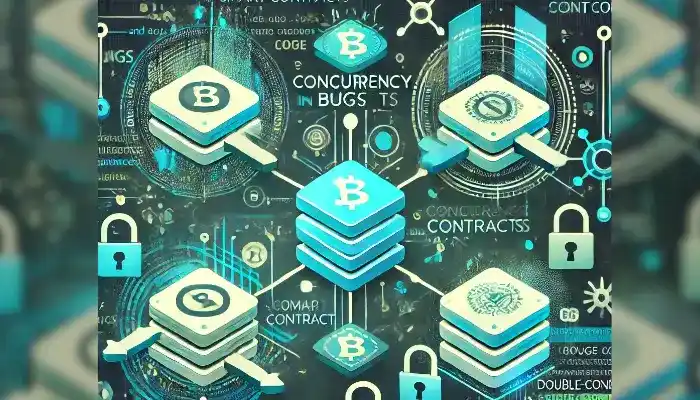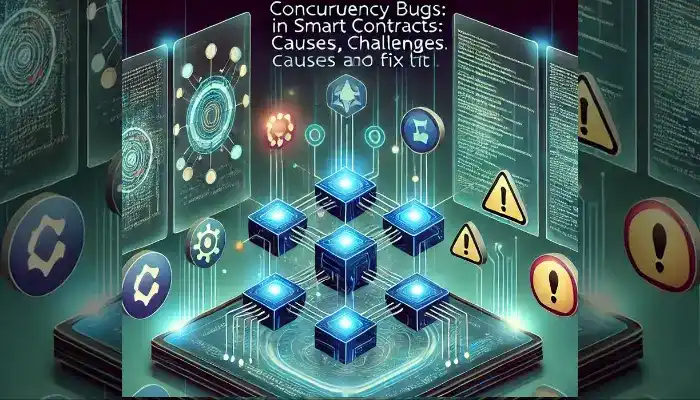When too many action happens at that same time, smart contracts on the blockchain might run into some issues that are not expected. One of the common reasons for that is something called “Concurrency bugs”. These bugs are expected to happen when two or more actions try to use the same resource at the same time, it’s like a lot of people are trying to walk through a narrow door together.
Here we will try to cover all the topics- What these bugs are, why they occur, problems they can cause, and most importantly how to solve them.
What is concurrency in blockchain?
Concurrency in blockchain happens when a lot of action is taking place using the same resource at the same time. This can lead to many problems if not managed properly such as two users trying to spend the same cryptocurrency These bugs are often caused by the race condition where a transaction may be called back before it even completes where one action could mess up another.
Learn about the blockchain here!
What Causes Concurrency Bugs?
Parallel Execution: Blockchain systems may handle a number of transactions in one way or another. If two transactions try to change the same data as time but for different data they are not changing the same thing in the system which results in errors.
Shared State: Smart contracts use shared data meaning different actions can often try to change the same information at once. This can lead to mistakes and make things unexpectedly turn the contract.
Non-Deterministic Operations: Since smart contracts are based on decentralized networks the order of transactions is potentially changing. This can cause a contract to give different results each time causing errors which can sometimes lead to confusion.
Challenges of Concurrency Bugs in Blockchain Smart Contracts
Concurrency bugs create a number of challenges, both for developers and users. Concurrency bugs can cause many issues that are both useful for developers and users.
Race Conditions: A race condition occurs when two actions are trying to change the same data at the same time. This can cause mistakes or unexpected results making the contract not work properly.
Re-entrancy Attacks: Hackers can use smart contracts by calling the contract once again before the first action is completed. This lets the company steal extra funds or change the contract in ways that it wasn’t meant to and creates serious security risks.
Double-Spending: Double-spending occurs when someone tries to use the same amount of money two times. The first is between two different transactions. It creates confusion and can lead to financial losses because the blockchain does not know which is a correct transaction.
Inconsistent States: Inconsistent states happen when certain parts of a system don’t update properly. This can cause some parts to have old or conflicting information that can make the contract behave unexpectedly.

Solutions to Concurrency Bugs in Blockchain Smart Contracts
To fix these concurrency bugs, here are some solutions that can help:
Locks and Mutexes: This makes sure that only one transaction can change the system at a time.
State Isolation: You separate the different tasks so that you don’t interfere with each other. When many transactions happen at once in a single transaction it will not cause a problem to mix data.
Atomic Transactions: It means that either everything happens in a transaction or nothing at all. This makes sure that the system updates properly without causing any problems.
Event-Driven Execution: It controls how the transaction is completed in order. By avoiding the error and making sure that the transaction took place in the right order it helps save the transaction.
Formal Verification: It uses math to check the system before it’s used. It helps us when we find the problem early and makes sure that the system is safe and works correctly.
Conclusion
Bugs can cause big problems in smart contracts and can cause large numbers of issues. They occur when multiple actions try to happen at the same time but they interfere with each other. This can lead to errors security risks or things not working as they should.
The good news? What can I do to slow the overall health issue? You can use locks to stop conflicts from occurring, keep tasks separate so they don’t overlap, and ensure transactions are either complete or not at all. Controlling orders of action and double-checking contracts can make them safer.
As blockchain technology becomes more popular fixing bugs is key to keeping apps secure and dependable. By using these simple means developers can create systems that are safer, reliable, and easier to trust.
For more technical insights into handling concurrency in blockchain, visit this detailed article: Adding Concurrency to Smart Contracts.
Related Posts:- Smart Contract Vulnerabilities: How Simple Errors Cause Millions in Losses

